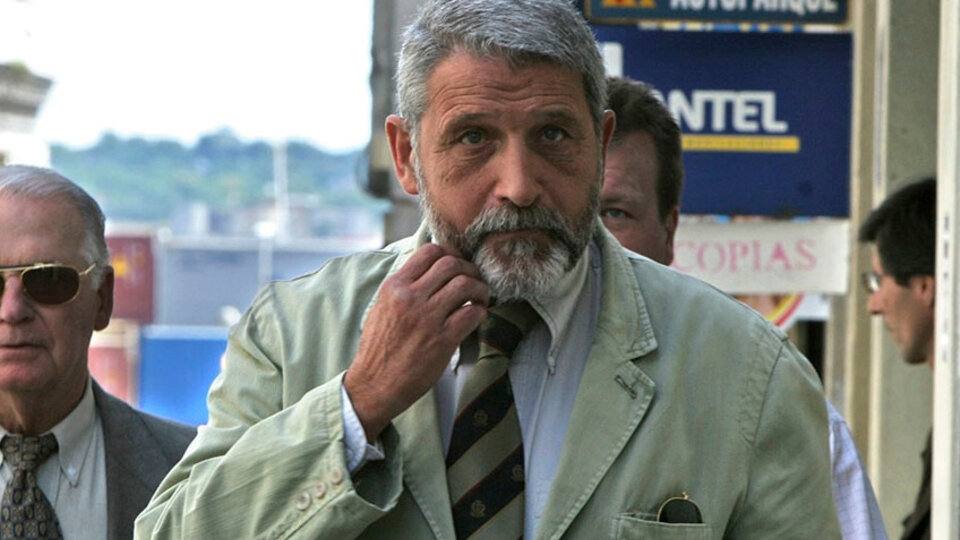
[ad_1]
He thought he had managed to hide in a “secluded and comfortable place”, but he was wrong. Finally, the Uruguayan repressor Eduardo Augusto Ferro, who had managed to escape the justice of his country, first, Yes then the international, he was stopped in Spain. Within the framework of Condor map, whose application was one of the officials in the eastern territory, is accused of kidnapping and disappearance of trade union leaders and political activists.
Ferro was on the run since mid-2017. This was declared by Uruguayan justice in the middle of that year, when the repressor had to go to the office of Judge Dolores Sánchez, head of Criminal Court No. 10 in Montevideo and did not do so. It was the second time that Sánchez had summoned him to inquire about the kidnapping and disappearance of communist activist Óscar Tassino, which occurred in 1977, and on this occasion he had not come either. After the second foul, the magistrate ordered his international capture. He was ordered not to leave the country.
Double leak
Ferro it’s a retired colonel. Military sources confirmed to local media that the repressor had fled abroad. He was arrested in Madrid in September of the same year and spent time in prison. Through Uruguayan justice, the charges of enforced disappearance, homicide, genocide, torture and serious deprivation of liberty during the dictatorship in this country fall to him.
However, he was quickly granted parole. And by the time the extradition request officially arrived, in June 2018, Ferro had fled again. In a dialogue with Uruguayan media La Diaria, the plaintiff lawyer in the case investigating the disappearance of Tassino, Martín Fernández, described the extradition as “a situation unprecedented in the history of international criminal cooperation “, the parole granted to Ferro during the extradition procedure, which allowed him to escape Spanish justice. “For a prosecutor, asking for the parole of a person whom the state has to hand over to another country is a serious situation. We hope that Spanish justice will act with the required speed, ”he commented yesterday.
Since that episode, Ferro’s whereabouts were unknown until Wednesday. A few months ago, the Uruguayan journalist Alfonso Lessa agreed to interview him, which the repressor himself had requested. He assured Lessa that he was still in Spain, in “an isolated place (…), reserved, in a small town, but hey, comfortable”. In this interview, the repressor referred to the disappearances of activists executed during the military dictatorship in Uruguay, which he considered “a bad decision from a strategic and inhuman point of view”. And he also ruled out immediately appearing in court. According to him, the Uruguayan prosecution in charge of the investigation of crimes against humanity “smells of total revenge”.
Finally it was arrested in the municipality of Peñíscola, in ValenciaUruguayan newspaper El País reported. Meanwhile, Fernández assured La Diaria that it was a matter of coordination between the Uruguayan and Spanish judicial authorities to define Ferro’s situation. For the moment, the Uruguayan justice has rejected all the appeals that the defense of the repressor presented to avoid extradition, of which the only thing pending is the surrender, they stressed in the newspaper.
Protagonist of the Condor plan
The judicial investigation carried out by Sánchez into the kidnapping and disappearance of Tassino indicates that Ferro was the protagonist in the implementation of the Condor plan in Uruguay. For this same case, Ferro had been investigated and began to stand trial in 1985, but benefited from the expiration law and was suspended. The case was reopened in 2011.
However, those Tassino suffered are not the only crimes committed during state terrorism in the region in which the retired colonel is implicated. Uruguayan media Sudestada reported that Ferro was a member of the “OCOA gang” (Office for the Coordination of Anti-Subversive Operations), along with José Nino Gavazzo, Jorge Silveira, Ernesto Ramas and Manuel Cordero, among other repressors. And that he participated in the disappearances and murders of Communist leader Fernando Miranda, María Claudia García de Gelman, as well as in the kidnapping in Brazil of Universindo Rodríguez and Lilián Celiberti, and in the torture and disappearance of Andrés Bellizzi and Jorge Gonçalvez in Argentina.
.
[ad_2]
Source link
 Naaju Breaking News, Live Updates, Latest Headlines, Viral News, Top Stories, Trending Topics, Videos
Naaju Breaking News, Live Updates, Latest Headlines, Viral News, Top Stories, Trending Topics, Videos